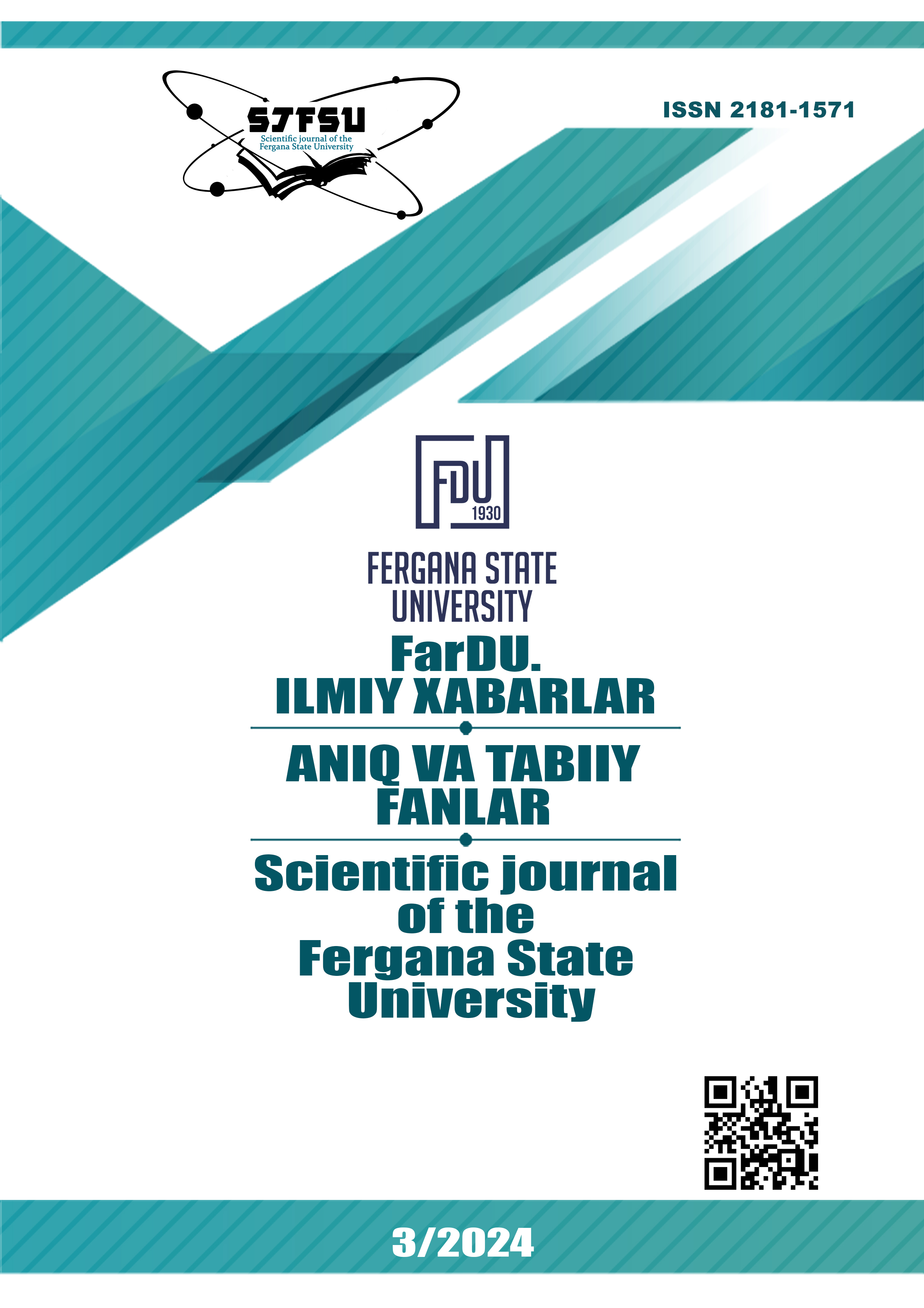QUANTITATIVE COMPOSITION OF CHEMICAL ELEMENTS AND VITAMINES OF PHLOMOIDES SPECIOSA
Main Article Content
Abstract
The article presents the results of experimental determination of the quantitative composition of 44 elements in flowers, stems and leaves of the Phlomoides speciosa plant using the ICP-MS inductively coupled plasma mass spectrometry method. NEXION-2000 equipment was used. Main quantitative components in flowers: Potassium, K 5487,875; Phosphorus, P 3791,449; Magnesium, Mg 1849.238; Calcium, Ca 1325,689. These elements are also the main elements in leaves and stems, but potassium and calcium are 7-8 times more abundant in stems. The amount of vitamins in plant raw materials was determined by the HPLC method. It was shown that the main quantitative component is ascorbic acid (2.0784 mg/g) and the largest amount of adermin (1.8146 mg/g) of substances belonging to the group of four B vitamins.
Article Details

This work is licensed under a Creative Commons Attribution-NonCommercial-NoDerivatives 4.0 International License.
References
Флора Узбекистана. – Ташкент : Изд. АН Уз ССР, 1955. – С. 43.
Haydarova D., Siddikov G‘, Abdullayev Sh., Tojiboyev B. The Composition of the Essential Oil of the Plant Phlomoides Nuda Growing in Uzbekistan. // International Journal of Multicultural and Multireligious Understanding. http://ijmmu.com ISSN 2364-5369 Volume 8, Issue 9 September, 2021 Pages: 396-400
Zopnik // Kazakhstan. National Encyclopedia. - Almaty: Kazakh encyclopedias, 2005. - T. II. - ISBN 9965-9746-3-2. [Published in Russian].
Rahimova, H.R (2021). Kompleks uglevodov Phlomoides canescens rasprostranen v Ferganskoy doline. Aziatskiy jurnal mnogomernыx issledovaniy , 10 (10), 1154–1159.
.H.Rahimova, A.Ibragimov Phlomoides sanescens o‘simligining uchuvchan moddalarini tadqiq etish . FarDU. ILMIY XABARLAR.3-2022.289-293 bet.
Wild edible plants / Ed. acad. V.A.Keller; Acad- emy of Sciences of the USSR; Moscow nerd. garden and Ying t history mater. culture them. N. Ya. Marr. - M .: b. i., 1941, P. 25-40. [Published in Russian].
Rudnyanskaya E.I. Pollen productivity of some plants // Beekeeping: journal. - 1985. - No. 2. - P. 16. [Pub- lished in Russian].
D. N. Olennikov, N. K. Chirikova. Phlotuber- osides I and II, New Iridoid Glycosides from Phlomoides tuberosa (English) // Chemistry of Natural Compounds. - 2017-3. - Vol. 53, iss. 2. - P. 269-272.
Adylov T.A., Makhmedov A.M. Genus Phlomoides Moench - Flomoides // Keys to plants of Central Asia. - Tashkent: Fan, 1987. – Т. 9. Р. 104-105. [Published in Russian].
Lazkov G.A. Genus Phlomoides (Lamiaceae) in Kirghizia // Komorovia. 2011. V. 7. P. 18.
Muzgin V.N., Emelyanova N.N., Pupyshev A.A. Inductively coupled plasma mass spectrometry- a new method in analytical chemistry // Analytics and Con- trol. 1998. No. 3-4. S. 3–25
П.Игамбердиева, A.Ибрагимов. Изучение распространения химических элементов в органах Artemisia ferganensis и Artemisia annua в зависимости от порядкового номера в периодической системе Д.И. Менделеева. Узбекский химический журнал. Ташкент. 2009. С. 35-39.
П.Игамбердиева, A.Ибрагимов. Изучение химических компонентов Artemisia ferganensis (полынь ферганская). Материалы Научно-практической конференции“Актуальные проблемы школьного химического образования”, посвященная 42-ой Международной Менделеевской олимпиаде”. Ташкент,
С. 102-104.
Флора Узбекистана. – Ташкент : Изд. АН Уз ССР, 1955. – С. 43.
Haydarova D., Siddikov G‘, Abdullayev Sh., Tojiboyev B. The Composition of the Essential Oil of the Plant Phlomoides Nuda Growing in Uzbekistan. // International Journal of Multicultural and Multireligious Understanding. http://ijmmu.com ISSN 2364-5369 Volume 8, Issue 9 September, 2021 Pages: 396-400
Zopnik // Kazakhstan. National Encyclopedia. - Almaty: Kazakh encyclopedias, 2005. - T. II. - ISBN 9965-9746-3-2. [Published in Russian].
Rahimova, H.R (2021). Kompleks uglevodov Phlomoides canescens rasprostranen v Ferganskoy doline. Aziatskiy jurnal mnogomernыx issledovaniy , 10 (10), 1154–1159.
.H.Rahimova, A.Ibragimov Phlomoides sanescens o‘simligining uchuvchan moddalarini tadqiq etish . FarDU. ILMIY XABARLAR.3-2022.289-293 bet.
Wild edible plants / Ed. acad. V.A.Keller; Acad- emy of Sciences of the USSR; Moscow nerd. garden and Ying t history mater. culture them. N. Ya. Marr. - M .: b. i., 1941, P. 25-40. [Published in Russian].
Rudnyanskaya E.I. Pollen productivity of some plants // Beekeeping: journal. - 1985. - No. 2. - P. 16. [Pub- lished in Russian].
D. N. Olennikov, N. K. Chirikova. Phlotuber- osides I and II, New Iridoid Glycosides from Phlomoides tuberosa (English) // Chemistry of Natural Compounds. - 2017-3. - Vol. 53, iss. 2. - P. 269-272.
Adylov T.A., Makhmedov A.M. Genus Phlomoides Moench - Flomoides // Keys to plants of Central Asia. - Tashkent: Fan, 1987. – Т. 9. Р. 104-105. [Published in Russian].
Lazkov G.A. Genus Phlomoides (Lamiaceae) in Kirghizia // Komorovia. 2011. V. 7. P. 18.
Muzgin V.N., Emelyanova N.N., Pupyshev A.A. Inductively coupled plasma mass spectrometry- a new method in analytical chemistry // Analytics and Con- trol. 1998. No. 3-4. S. 3–25
П.Игамбердиева, A.Ибрагимов. Изучение распространения химических элементов в органах Artemisia ferganensis и Artemisia annua в зависимости от порядкового номера в периодической системе Д.И. Менделеева. Узбекский химический журнал. Ташкент. 2009. С. 35-39.
П.Игамбердиева, A.Ибрагимов. Изучение химических компонентов Artemisia ferganensis (полынь ферганская). Материалы Научно-практической конференции“Актуальные проблемы школьного химического образования”, посвященная 42-ой Международной Менделеевской олимпиаде”. Ташкент,
С. 102-104.

